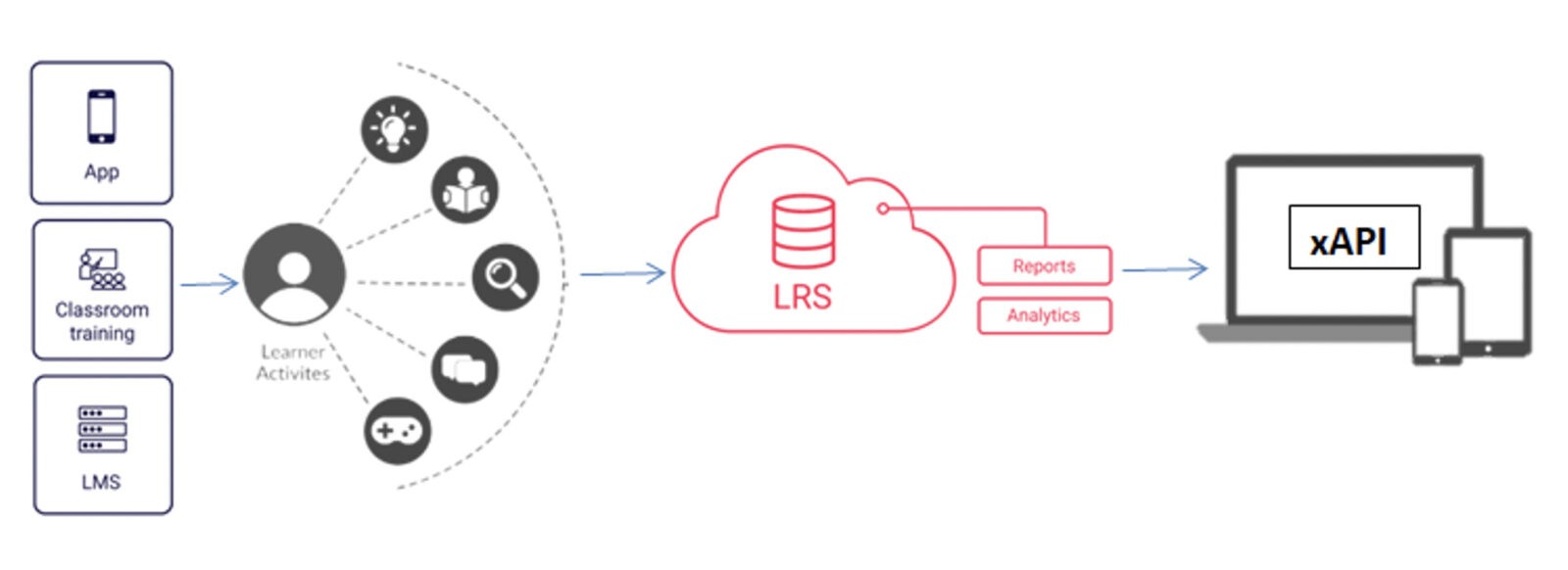SCORM, which stands for Shareable Content Object Reference Model, is a set of technical standards for eLearning software applications that allows online learning content and Learning Management Systems (LMSs) to communicate with each other and record and track the data.
To overcome the limitations of the traditional AICC (Aviation Industry Computer-Based Training Committee)- and SCORM-based eLearning, the ADL Initiative in 2010 relieved new standardized experience tracking capabilities that could support emerging devices and technologies used for learning. The name for the project was “Project Tin Can”, and later officially named the specification as the xAPI.
The xAPI stands for Experience API, which is a data and interface standard. The software application allows learning content and learning systems to capture and share (big) data on user performance. The software was developed in 2013 to capture the learner’s experience; such learning analytics has helped to revolutionize the way education and training are conducted, managed, and measured.
Why is xAPI important?
xAPI helps provide better insight into the learning process and solves many inherent issues with older versions of SCORM. Mobile learning, collaborative learning, cross-domain functionality, and simulation-based learning with real-world scenarios are among few features that are now relatively easy to accomplish.
xAPI is designed for interoperability; hence it allows LRSs (Learning Record Stores) to share data and transcripts from one LRS (or organization) to another. This can enable learners to store their personal learning information, thus making their learning experience more efficient.
Learning Record Stores
LRSs are an integral part of the functional xAPI implementation as it validates and stores all the xAPI statements. These data stores may be part of an LMS or other learning software package or applications. LRSs are responsible for storing, retrieving, and often analyzing data on learning experiences based on the learners’ activities and performances.
How does xAPI Works?
xAPI transforms a learning experience by converting data to practical knowledge that’s quantifiable, making corporate learning more effective. It allows employees and managers of online learning programs to understand how users benefit from the learning program. The ability to track the user’s learning progress across multiple platforms indicates that the data is complete and holistic.
The eLearning software specification led by xAPI produces simple activity statements using basic grammar rules (actor-verb-direct object) – actor refers to the learner/user, verb narrates the action (i.e. completing a course) by the learner/user. In contrast, the object (mobile tutorial) represents what the learner has interacted with.

xAPI extracts click-by-click details about how the user has navigated through all the courses. And, then the API open source records the data highlighting the learner’s progress and showcasing the activities where the learner has faced difficulty – in real-time.
Why Use xAPI?
xAPI’s ability to continuously track experiences enables the organization to personalize the content per the user’s needs, creating effective learning solutions to achieve overall business success.
Here are few benefits that xAPI offers to organizations enabling them to achieve their L&D goals:
Tracks holistic data to generate better ROI analysis:
Performance tracking can improve the efficiency of a corporate learning program as the L&D leaders can use the data to decide what kind of content works the best for them. Consequently, it provides them with a clear roadmap of where to invest their money and how to invest it. Utilizing the data to create actionable goals can significantly improve the company’s return on investment for training programs.
Improves learning involvement and engagement:
With actionable insights into employee development, L&D leaders can use the data to implement changes to enhance training and upgrade the content to support the needs of the employees. The experiences that xAPI tracks and stores allow the organization to control all learning aspects and make content changes to make the training more meaningful and relevant to the learners’ needs.
Scalable and integrated:
xAPI offers connectivity between all corporate learning programs and software that employees can access from a single portal. Such flexibility enables a business in building an organization-wide universal training tool. Employees can quickly gain new knowledge and master new processes anywhere and anytime without conflicting with other essential or time-sensitive work tasks.
Offers multi-device support:
Another significant benefit of xAPI is that it can function independently of web browsers. Such a feature can enable organizations to create specially designed courses for smartphone users for a better learning experience. Unlike other traditional applications, it supports the availability of the same course on various devices, including computers, smartphones, laptops, and tablets.
Supports offline access:
xAPI allows the learners to synchronize with the server and access course materials, activities, and content while being offline. Even if the training is completed offline, the user’s experiences will be uploaded to the LRS once connected to the internet. This enables the learners to access the courses at a time that’s convenient to them.